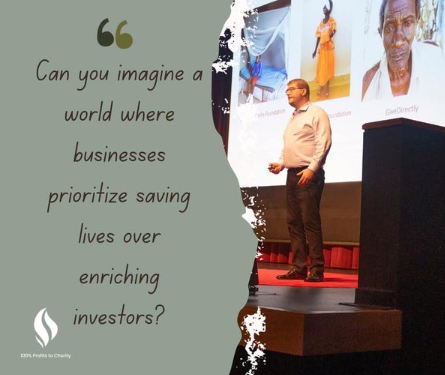November 30th is International Day of Climate Action. We thank our wonderful contributor Brad Hurley for this great piece about the broad range of ways our recommended charities are protecting and improving the environment at the same time that they protect and improve lives.
When we give to a charity, we usually think in terms of supporting a specific cause or outcome. If I give to Village Enterprise, I’m helping to empower low-income individuals in Africa to launch and grow their own businesses. If I give to One Acre Fund, I’m helping to improve the productivity of smallholder farmers. But the work of effective charities can bring a range of benefits that reach far beyond the main focus of their interventions.
Co-Benefits Matter

Tanzanian farmers Suzana Chavargino and Jimmy Nziku with two solar lights they purchased from One Acre Fund on credit.
For example, research shows that increases in life expectancy at birth and decreases in maternal, infant, and child mortality are associated with improvements in economic growth. One recent study of 48 African countries found that a 9.4-year increase in life expectancy leads to a 1 percent increase in real gross domestic product per capita. This means that when you give to charities such as the Against Malaria Foundation, Global Alliance for Improved Nutrition, Iodine Global Network, or Population Services International, you’re not just saving lives. You’re also helping to promote longer-term economic growth in countries that desperately need it.
Similarly, the work of effective charities can have environmental benefits, such as improving air quality, reducing greenhouse gas emissions, preserving habitat, and reducing hunting pressure on endangered or rare species. If, like me, you care about these things, environmental co-benefits can play a role in your giving choices.
Integrating Environmental Priorities into Charities’ Work
Some effective charities explicitly incorporate environmental criteria and goals into their interventions. Oxfam, for example, has long been involved in efforts to limit climate change and build resilience to its impacts in developing countries. In addition to saving lives at scale and reducing under-5 child mortality, Living Goods’ entrepreneurial community health workers sell efficient cookstoves and solar lights along with healthcare products. In East and Southern Africa, One Acre Fund distributes solar-powered lamps and home systems as well as clean cookstoves on credit to smallholder farmers.
Innovations for Poverty Action (IPA) runs a Financial Inclusion program that helps build low-income households’ resilience to climate change and other stressors. IPA also has evaluated a number of projects that aim to provide environmental benefits, to improve our understanding of how to respond to climate change. Projects include evaluating an initiative to promote carbon sequestration by farmers, understanding renewable energy installations, experiments to improve participation in recycling programs, and a study in Uganda to assess whether paying farmers to leave trees standing would reduce deforestation. In that project, landowners who received contracts to conserve their forest cleared only 4 percent of forested land, compared with 9 percent in control villages, avoiding 3,000 metric tons of carbon dioxide emissions that otherwise would have occurred during the study period.
Other charities are working to document the environmental benefits of their activities. For example, Village Enterprise and the African Wildlife Foundation launched a partnership in 2018 to reduce poverty and protect an endangered population of bonobos in the Democratic Republic of the Congo. The project aims to develop microenterprises, using Village Enterprise’s graduation model, that offer alternative livelihoods to the hunting and selling of bushmeat, a widespread source of income in poorer rural areas of the country. The two nonprofits intend to explore how to scale their partnership to other regions.
Capturing the Indirect Benefits
The work of charities such as Village Enterprise, Oxfam, Living Goods, Give Directly, and others that focus on reducing or ending poverty can also lead to some types of environmental benefits indirectly through economic improvements. The relationships between economic growth and environmental quality are complex and inconsistent, but there is evidence that at least some environmental indicators (e.g., sanitation and water quality) tend to improve as poverty declines. And as renewable energy technologies become more widespread and affordable, some countries may even be able to avoid significant increases in greenhouse gas emissions as their economies grow.
When we think about effective giving, it’s worth considering the impact of ancillary environmental and economic benefits that may result from the interventions of charities we give to. Positive environmental benefits add to total effectiveness, increasing the good that you ultimately achieve with your giving and may contribute toward the long-term sustainability and health of populations served by the charities you help fund.



